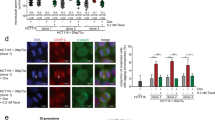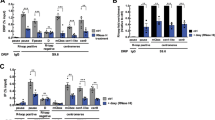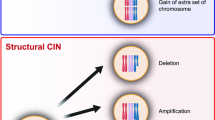Abstract
Most human cancers show chromosomal instability (CIN), but the precise mechanisms remain uncertain. Annexin A2 is frequently overexpressed in human cancers, and its relationship to tumorigenesis is poorly understood. We found that annexin A2 is overexpressed in the nuclei of CIN cells compared with cells with microsatellite instability (MIN). Ectopic annexin A2 expression in MIN cells results in a high level of aneuploidy and induces lagging chromosomes; suppression of annexin A2 in CIN cells reduces such CIN signatures with apoptosis of highly aneuploid cells. Ectopic expression of annexin A2 in MIN cells reduces the expression of centromere proteins. Conversely, annexin A2-knockdown in CIN cells increases the expression of centromere proteins. Moreover, the endogenous expression levels of centromere proteins in CIN cells were greatly reduced compared with MIN cell lines. The reduced expression of centromere proteins likely occurred due to aberrant centromere localization of coilin, a major component of the Cajal bodies. These results suggest that nuclear accumulation of annexin A2 has a crucial role in CIN by disrupting centromere function.
This is a preview of subscription content, access via your institution
Access options
Subscribe to this journal
Receive 50 print issues and online access
$259.00 per year
only $5.18 per issue
Buy this article
- Purchase on Springer Link
- Instant access to full article PDF
Prices may be subject to local taxes which are calculated during checkout







Similar content being viewed by others
References
Lengauer C, Kinzler KW, Vogelstein B . Genetic instability in colorectal cancers. Nature 1997; 386: 623–627.
Lengauer C, Kinzler KW, Vogelstein B . Genetic instabilities in human cancers. Nature 1998; 396: 643–649.
Jallepalli PV, Waizenegger IC, Bunz F, Langer S, Speicher MR, Peters JM et al. Securin is required for chromosomal stability in human cells. Cell 2001; 105: 445–457.
Barber TD, McManus K, Yuen KW, Reis M, Parmigiani G, Shen D et al. Chromatid cohesion defects may underlie chromosome instability in human colorectal cancers. Proc Natl Acad Sci USA 2008; 105: 3443–3448.
Zhang N, Ge G, Meyer R, Sethi S, Basu D, Pradhan S et al. Overexpression of Separase induces aneuploidy and mammary tumorigenesis. Proc Natl Acad Sci USA 2008; 105: 13033–13038.
Solomon DA, Kim T, Diaz-Martinez LA, Fair J, Elkahloun AG, Harris BT et al. Mutational inactivation of STAG2 causes aneuploidy in human cancer. Science 2011; 333: 1039–1043.
Cahill DP, Lengauer C, Yu J, Riggins GJ, Willson JK, Markowitz SD et al. Mutations of mitotic checkpoint genes in human cancers. Nature 1998; 392: 300–303.
Hanks S, Coleman K, Reid S, Plaja A, Firth H, Fitzpatrick D et al. Constitutional aneuploidy and cancer predisposition caused by biallelic mutations in BUB1B. Nat Genet 2004; 36: 1159–1161.
Bischoff JR, Anderson L, Zhu Y, Mossie K, Ng L, Souza B et al. A homologue of Drosophila aurora kinase is oncogenic and amplified in human colorectal cancers. EMBO J 1998; 17: 3052–3065.
Zhou H, Kuang J, Zhong L, Kuo WL, Gray JW, Sahin A et al. Tumour amplified kinase STK15/BTAK induces centrosome amplification, aneuploidy and transformation. Nat Genet 1998; 20: 189–193.
Ganem NJ, Godinho SA, Pellman D . A mechanism linking extra centrosomes to chromosomal instability. Nature 2009; 460: 278–282.
Silkworth WT, Nardi IK, Scholl LM, Cimini D . Multipolar spindle pole coalescence is a major source of kinetochore mis-attachment and chromosome mis-segregation in cancer cells. PLoS One 2009; 4: e6564.
Fodde R, Kuipers J, Rosenberg C, Smits R, Kielman M, Gaspar C et al. Mutations in the APC tumour suppressor gene cause chromosomal instability. Nat Cell Biol 2001; 3: 433–438.
Kaplan KB, Burds AA, Swedlow JR, Bekir SS, Sorger PK, Nathke IS . A role for the Adenomatous Polyposis Coli protein in chromosome segregation. Nat Cell Biol 2001; 3: 429–432.
Green RA, Kaplan KB . Chromosome instability in colorectal tumor cells is associated with defects in microtubule plus-end attachments caused by a dominant mutation in APC. J Cell Biol 2003; 163: 949–961.
Kops GJ, Foltz DR, Cleveland DW . Lethality to human cancer cells through massive chromosome loss by inhibition of the mitotic checkpoint. Proc Natl Acad Sci USA 2004; 101: 8699–8704.
Bakhoum SF, Thompson SL, Manning AL, Compton DA . Genome stability is ensured by temporal control of kinetochore-microtubule dynamics. Nat Cell Biol 2009; 11: 27–35.
Bakhoum SF, Genovese G, Compton DA . Deviant kinetochore microtubule dynamics underlie chromosomal instability. Curr Biol 2009; 19: 1937–1942.
Tomonaga T, Matsushita K, Yamaguchi S, Oohashi T, Shimada H, Ochiai T et al. Overexpression and mistargeting of centromere protein-A in human primary colorectal cancer. Cancer Res 2003; 63: 3511–3516.
Tomonaga T, Matsushita K, Ishibashi M, Nezu M, Shimada H, Ochiai T et al. Centromere protein H is up-regulated in primary human colorectal cancer and its overexpression induces aneuploidy. Cancer Res 2005; 65: 4683–4689.
Kuga T, Nie H, Kazami T, Satoh M, Matsushita K, Nomura F et al. Lamin B2 prevents chromosome instability by ensuring proper mitotic chromosome segregation. Oncogenesis 2014; 3: e94.
Wang JL, Gray RM, Haudek KC, Patterson RJ . Nucleocytoplasmic lectins. Biochim Biophys Acta 2004; 1673: 75–93.
Kumble KD, Iversen PL, Vishwanatha JK . The role of primer recognition proteins in DNA replication: inhibition of cellular proliferation by antisense oligodeoxyribonucleotides. J Cell Sci 1992; 101 (Pt 1): 35–41.
Vishwanatha JK, Kumble S . Involvement of annexin II in DNA replication: evidence from cell-free extracts of Xenopus eggs. J Cell Sci 1993; 105 (Pt 2): 533–540.
Esposito I, Penzel R, Chaib-Harrireche M, Barcena U, Bergmann F, Riedl S et al. Tenascin C and annexin II expression in the process of pancreatic carcinogenesis. J Pathol 2006; 208: 673–685.
Sharma MR, Koltowski L, Ownbey RT, Tuszynski GP, Sharma MC . Angiogenesis-associated protein annexin II in breast cancer: selective expression in invasive breast cancer and contribution to tumor invasion and progression. Exp Mol Pathol 2006; 81: 146–156.
Duncan R, Carpenter B, Main LC, Telfer C, Murray GI . Characterisation and protein expression profiling of annexins in colorectal cancer. Br J Cancer 2008; 98: 426–433.
Thompson SL, Compton DA . Examining the link between chromosomal instability and aneuploidy in human cells. J Cell Biol 2008; 180: 665–672.
Eberhard DA, Karns LR, VandenBerg SR, Creutz CE . Control of the nuclear-cytoplasmic partitioning of annexin II by a nuclear export signal and by p11 binding. J Cell Sci 2001; 114: 3155–3166.
Bayani J, Selvarajah S, Maire G, Vukovic B, Al-Romaih K, Zielenska M et al. Genomic mechanisms and measurement of structural and numerical instability in cancer cells. Semin Cancer Biol 2007; 17: 5–18.
Morency E, Sabra M, Catez F, Texier P, Lomonte P . A novel cell response triggered by interphase centromere structural instability. J Cell Biol 2007; 177: 757–768.
Raska I, Andrade LE, Ochs RL, Chan EK, Chang CM, Roos G et al. Immunological and ultrastructural studies of the nuclear coiled body with autoimmune antibodies. Exp Cell Res 1991; 195: 27–37.
Stoler S, Keith KC, Curnick KE, Fitzgerald-Hayes M . A mutation in CSE4, an essential gene encoding a novel chromatin-associated protein in yeast, causes chromosome nondisjunction and cell cycle arrest at mitosis. Genes Dev 1995; 9: 573–586.
Howman EV, Fowler KJ, Newson AJ, Redward S, MacDonald AC, Kalitsis P et al. Early disruption of centromeric chromatin organization in centromere protein A (Cenpa) null mice. Proc Natl Acad Sci USA 2000; 97: 1148–1153.
Kalitsis P, Fowler KJ, Earle E, Hill J, Choo KH . Targeted disruption of mouse centromere protein C gene leads to mitotic disarray and early embryo death. Proc Natl Acad Sci USA 1998; 95: 1136–1141.
Thompson SL, Bakhoum SF, Compton DA . Mechanisms of chromosomal instability. Curr Biol 2010; 20: R285–R295.
Tomonaga T, Nomura F . Chromosome instability and kinetochore dysfunction. Histol Histopathol 2007; 22: 191–197.
Liu J, Rothermund CA, Ayala-Sanmartin J, Vishwanatha JK . Nuclear annexin II negatively regulates growth of LNCaP cells and substitution of ser 11 and 25 to glu prevents nucleo-cytoplasmic shuttling of annexin II. BMC Biochem 2003; 4: 10.
Tomas A, Futter C, Moss SE . Annexin 11 is required for midbody formation and completion of the terminal phase of cytokinesis. J Cell Biol 2004; 165: 813–822.
Everett RD, Earnshaw WC, Findlay J, Lomonte P . Specific destruction of kinetochore protein CENP-C and disruption of cell division by herpes simplex virus immediate-early protein Vmw110. EMBO J 1999; 18: 1526–1538.
Lomonte P, Everett RD . Herpes simplex virus type 1 immediate-early protein Vmw110 inhibits progression of cells through mitosis and from G(1) into S phase of the cell cycle. J Virol 1999; 73: 9456–9467.
Sawyers CL . Research on resistance to cancer drug Gleevec. Science 2001; 294: 1834.
Wang TL, Diaz LA Jr, Romans K, Bardelli A, Saha S, Galizia G et al. Digital karyotyping identifies thymidylate synthase amplification as a mechanism of resistance to 5-fluorouracil in metastatic colorectal cancer patients. Proc Natl Acad Sci USA 2004; 101: 3089–3094.
Chuthapisith S, Layfield R, Kerr ID, Hughes C, Eremin O . Proteomic profiling of MCF-7 breast cancer cells with chemoresistance to different types of anti-cancer drugs. Int J Oncol 2007; 30: 1545–1551.
Takano S, Togawa A, Yoshitomi H, Shida T, Kimura F, Shimizu H et al. Annexin II overexpression predicts rapid recurrence after surgery in pancreatic cancer patients undergoing gemcitabine-adjuvant chemotherapy. Ann Surg Oncol 2008; 15: 3157–3168.
Nishimori T, Tomonaga T, Matsushita K, Oh-Ishi M, Kodera Y, Maeda T et al. Proteomic analysis of primary esophageal squamous cell carcinoma reveals downregulation of a cell adhesion protein, periplakin. Proteomics 2006; 6: 1011–1018.
Tomonaga T, Matsushita K, Yamaguchi S, Oh-Ishi M, Kodera Y, Maeda T et al. Identification of altered protein expression and post-translational modifications in primary colorectal cancer by using agarose two-dimensional gel electrophoresis. Clin Cancer Res 2004; 10: 2007–2014.
Seimiya M, Tomonaga T, Matsushita K, Sunaga M, Oh-Ishi M, Kodera Y et al. Identification of novel immunohistochemical tumor markers for primary hepatocellular carcinoma; clathrin heavy chain and formiminotransferase cyclodeaminase. Hepatology 2008; 48: 519–530.
Acknowledgements
We thank Masumi Ishibashi and Nobuko Tanaka for technical assistance. This work was supported by Grants-in-Aid from the Ministry of Education, Science, Sports and Culture of Japan.
Author information
Authors and Affiliations
Corresponding author
Ethics declarations
Competing interests
The authors declare no conflict of interest.
Additional information
Supplementary Information accompanies this paper on the Oncogene website
Rights and permissions
About this article
Cite this article
Kazami, T., Nie, H., Satoh, M. et al. Nuclear accumulation of annexin A2 contributes to chromosomal instability by coilin-mediated centromere damage. Oncogene 34, 4177–4189 (2015). https://doi.org/10.1038/onc.2014.345
Received:
Revised:
Accepted:
Published:
Issue Date:
DOI: https://doi.org/10.1038/onc.2014.345
This article is cited by
-
EphA2–YES1–ANXA2 pathway promotes gastric cancer progression and metastasis
Oncogene (2021)
-
Selective imaging of solid tumours via the calcium-dependent high-affinity binding of a cyclic octapeptide to phosphorylated Annexin A2
Nature Biomedical Engineering (2020)
-
Annexin A2-mediated cancer progression and therapeutic resistance in nasopharyngeal carcinoma
Journal of Biomedical Science (2018)



